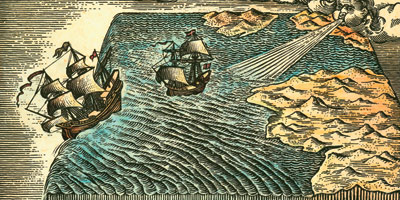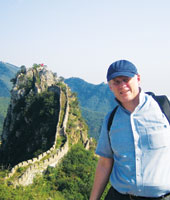Globalization and the Flat World
Thomas Friedman’s journalistic voyage
should stimulate our thinking — and our action

“Columbus was searching for hardware — precious metals, silk, and spices — the sources of wealth in his day. I was searching for software, brainpower, complex algorithms, knowledge workers, call centers, transmission protocols, breakthroughs in optical engineering — the sources of wealth in our day.”
–Thomas Friedman, The World Is Flat
Traveling in China last fall, I marveled again at the existence of the ATM. Whenever it suited me, I could walk up to a machine, insert a plastic card, and retrieve Chinese yuan from my American bank account. When you stop to think about it, it’s amazing that this now-mundane invention even works at all. Imagine the intricate technological networking required for a transaction that instantly delivers my money to me no matter where I am in the world.
This is globalization, or at least a very small example of a very big phenomenon. The world, driven largely by advances in technology, has become inextricably interconnected across distances and other boundaries.
Arguably one of the most influential popular writers on the nature of globalization is Thomas Friedman, New York Times foreign affairs columnist. His most recent best-seller, The World Is Flat: A Brief History of the Twenty-First Century, is one of several books that students in the University Scholars program at Seattle Pacific University will be reading in a new class to be offered for the first time this spring: “Texts and Contexts IV: Globalization.”
In The World Is Flat, Friedman takes the reader on a journey to locations across the globe, identifying a post-9/11 shift in the process of globalization he calls “flattening.” Due to a surprising and lightning-quick convergence of technologies, he argues, individuals (not just countries and companies) can now communicate “from anywhere to anywhere,” collaborating and competing for the first time on a level playing field.
Friedman’s 1999 best-seller, The Lexus and the Olive Tree: Understanding Globalization, explored the tension between globalization on one side, and culture, geography, tradition, and community on the other. But it is The World Is Flat, first published in 2005, that created the most widely used metaphor for globalization today. A recently released edition (Picador, 2007) includes new content, Friedman explains, because “the forces flattening the world didn’t stop when the first edition of this book was published.”

Douglas Downing, SPU Associate Professor of Economics |
For critics of globalization, Friedman illustrates its benefits; for champions of globalization, he discusses its problems. The World Is Flat is filled with stories — and answers to such fascinating questions as: What global strategy makes Wal-Mart so successful — and controversial? How is Costco different? Why and how does Boeing tie together engineers and suppliers worldwide? Why do workers in India take jobs answering phone calls from the United States and Europe? How has IBM reinvented itself, and who now owns IBM’s original personal computer business? Where in the world are Microsoft’s new research labs? Are two countries connected to the same supply chain less likely to go to war? What happens to jobs as the systems for creating value move from primarily vertical command-and-control systems to horizontal connect-and-collaborate systems?
Knowing what is going on in the world is the first step toward becoming educated about globalization. But how is it that we got to this place?
Technology, of course, is one of the major causes of the flattening of the globe. In The World Is Flat, Friedman identifies 10 “flatteners” that have reshaped business, our lives, and our world in the 21st century. He begins with the fall of the Berlin Wall in 1989, one of the most vivid examples of the impact of technology on human history.
For the first decades following World War II, the world was basically divided into three major trading blocs. Then advances in information technology created a dilemma for those regimes that tightly controlled the flow of information.
Leaders could either continue to deny their people access to information technology and see their economies fall further and further behind, or they could relinquish control of information. Russia moved toward openness, and the fall of the Berlin Wall marked the literal and symbolic disappearance of some of the barriers that had kept the world’s people apart.
From there, Friedman’s list of flattening influences includes such milestones as the advent of the Netscape web browser, work-flow software, outsourcing, offshoring, and
supply-chaining.
But in order to more fully understand the process of globalization, we particularly need to examine China — already a major actor in the world economy, and one that will become of increasing importance. China’s history teaches important lessons about how a nation can fall very far and then rise very fast in the era of globalization.
When Marco Polo visited 13th-century China, he found a rich land known for the invention of paper, printing, gunpowder, and the compass. China’s per-capita income exceeded that of European nations. In the early 15th century, however, China made a crucial turn toward isolationism, and for some reason the spirit of inventiveness faded. By the time European nations confronted China in the 19th century, the Europeans were much richer and stronger than China, and it was forced to accept humiliating colonial settlements. China was torn between adapting or resisting ideas from the West.
The 20th century brought more turmoil to China: the end of 2,000 years of imperial rule, constant battles between factions fighting for power, and foreign dominance during World War II. The People’s Republic promised a new beginning for China, but then its muddled economic policies caused famine in the late 1950s and the ruin of the educational system during the Cultural Revolution in the 1960s.
China changed course under Deng Xiaoping’s leadership in the late 1970s, and for the last 30 years, its goal has been modernization as it aims to again become one of the world’s richest countries. Fueled by a commitment to education, technological innovation, and global commerce, China’s resurgence as a world economic superpower has not come without challenges, however. Questions about the future of its political system, cultural traditions, low-wage working pool, product-quality standards, rapidly accumulating foreign currency reserves, environment — and moral foundation — all accompany the swift changes China is experiencing.
China’s successes and challenges help to highlight the single most important question concerning globalization: How should we respond to the extraordinary changes it brings? Whether we recognize it or not, globalization affects us all. We need to hear diverse viewpoints about the positive and negative effects of globalization, but simple answers will be inadequate as we decide how to conduct ourselves in the complex, globally connected, “flattened” world.
The concerns caused by globalization are myriad, including economic, environmental, security, personal privacy, and other issues. As Christians, however, we are first called to evaluate globalization by its effects on the poor. We must ask ourselves why some people in the world are poor and why others are not. We see hopeful signs as the world’s two most populous nations — China and India — have begun to create pathways for millions of people to escape poverty. Much human potential had previously been wasted in these countries when people were denied opportunity. However, with a combined population of 2.3 billion people in China and India alone, many still remain left behind.
Life has always been challenging for many people, but for much of human history, the challenges were very different. For instance, as recently as 150 years ago, 90 percent of Americans worked in agriculture. Growing enough food to survive was a major task, but people seldom needed to worry that their lives would be affected by events on the other side of the world. Today, the situation is reversed: There is little danger of famine caused by local crop failure, but there are major challenges from distant economic competitors linked to global networks. Responding to globalization as Christians means identifying and helping to mitigate against an entirely new set of threats to the world’s poor.
For those of us who are educators, Thomas Friedman reminds us of other important responsibilities as well. In The World Is Flat, he wonders whether the United States is like the third-generation members of a wealthy family who are no longer interested in doing hard work and are instead squandering their inheritance. Will U.S. students study enough math, science, and technology that they will be able to do the high-level jobs of the flat world? Are we too addicted to short-term gratification that sustained effort to master difficult subjects will be beyond our capability (or our will) to accomplish? Will reading for pleasure fade away among children in gadget-filled households? Will Americans learn the languages required to understand the rest of the world?
To fulfill our vision for engaging the culture and changing the world, Seattle Pacific will not only need to prepare students for the rapidly changing job market, but it will also need to ensure that they have the competence and character to confront global poverty, armed conflict, and unprecedented environmental challenges. For the SPU faculty, that means encouraging our students to read extensively about the rest of the world, to be informed about current events, to participate in some form of study-abroad program, and to heed the scriptural call that “from everyone who has been given much shall much be required.”
—By Douglas Downing, SPU Associate Professor of Economics [ddowning@spu.edu]
Back to the top
Back to Features Home
|